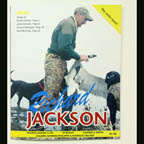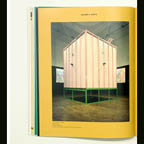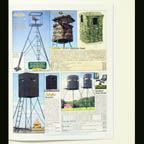
S H E L T E R
23 juni t/m 2 september 2007 Kasteel het Nijenhuis, Heino
 S H E L T E R 23 juni t/m 2 september 2007 Kasteel het Nijenhuis, Heino |
| Beeldende kunst | A_Z | |||
| JACKSON, Richard | ||||
 |  |  | ||
|
RICHARD
JACKSON Published on the occasion of the Richard Jackson
exhibition at NYEHAUS. I've been fascinated by Richard Jackson's work for years without ever seeing any of it in person. Poring over photographs in exhibition catalogues and art magazines, many of them from the 1970s, I perceived an artist whose boundary-breaking energy and painterly intelligence came through even in two-dimensional black and white. Many of the images I found were of installations in which stretched canvases were employed not only as supports for paint but also, indeed, chiefly, as tools for paint application. Beginning around 1970, Jackson, who was born in Sacramento in 1939 and has been living in Los Angeles since 1968, started sliding still-wet canvases across gallery walls to create temporary, abstract murals of impressive graphic power and formal variety. Yet, they don't come across as simply innovative formal experiments; even in photographic documentation there is a sense of critique, even of affectionate satire, directed against more conventional abstract painting. In these works, Jackson incorporated the canvases themselves into the murals, affixing them to the wall (painted side facing away from the viewer) to show how the work was made. There seems to be a tension between a passion for painting and an equally strong urge to thoroughly dismantle it. Just
as interesting as the wall paintings are installations in which Jackson used canvases
more structurally. At the Rosamund Felsen Gallery in Los Angeles in 1978, for
instance, he propped a 30-by-19-foot diamond-shaped canvas off the floor at an
oblique angle and then pushed a rectangular canvas freshly painted with primary
colors over it, realizing a piece that was half architecture, half abstract painting.
In the 1980s, he built huge enclosures and sculptural forms out of hundreds and
even thousands of painted canvases. Part of my attraction to Jackson's early work has to do with the way it seems to anticipate more recent work by Polly Apfelbaum, James Hyde, Fabian Marcaccio and Jessica Stockholder, New York-based artists who began to reengineer abstract painting in the mid-1980s. I doubt there was any direct influence: I've never heard any of them mention Jackson, and opportunities to see his work in person have been rare, particularly in New York. In some ways, it seems even more interesting if these trans-generational affinities were coincidental rather than causal, the result of artists arriving at the same place by different routes. (1) Having missed, to my great regret, Jackson's 1997 New York show at David Zwirner (his first solo exhibition in New York since 1974), I still hadn't seen any of his work until last winter, when Jackson was given a pair of simultaneous shows at two New York venues, Haswellediger & Co. Gallery and Foundation 20 21. These were followed up by a show this summer at Hauser & Wirth Gallery in London. For several decades, Jackson has exhibited more frequently in Europe than in the U.S.; he's one of many important veteran American artists who are better known in Germany than in their own country, where a hunger for novelty and youth all too often ends up marginalizing older artists. Reflecting how Jackson's work has evolved over the last 25 years (a subject that must wait for another occasion to be fully explored), the pieces in the two New York shows seemed to have little in common with the early works. At Haswellediger, Jackson presented two new pieces, Living Room and Dick's Deer (both 2004), sculptural installations that were completed just prior to the opening of the show by brief performative actions by the artist. The work at Foundation 20 21 (a Gramercy Park space that has since been reborn as a commercial gallery called Nyehaus), The Three Bears (2004), involved a similar process. Living Room consists of a simple wood cubicle with large openings approximating a doorway and two windows. In the gallery it was raised up from the floor several feet by a platform that housed a motor. Inside the room viewers could see a clunky easy chair, a coffee table, a television and a bear's head hunting trophy high on one wall. This meager ensemble was liberally splattered with red, green, blue and yellow acrylic paint, some of which had splashed on to the platform and the gallery floor. The paint had evidently been poured into the room from several white plastic buckets left standing on the platform. A DVD made by the gallery documents
how the room got so messy. In it, the artist is seen mixing paint in the buckets
and then turning on a motor which causes the floor of the room and its furnishings
to begin rapidly revolving. As chair and table whirl around, Jackson steps onto
the platform and carefully pours the paint through one of the windows. As it comes
in contact with the furniture some of the paint is flung around the room. From
atop a ladder, he then pours more paint through an opening in the cubicle's ceiling.
When he's satisfied with the results, he switches off the motor and the dripping,
newly colorful room comes to a gradual stop. 1959 - 1961 Studied Art and Engineering at Sacramento State College 1968 Moved to Los Angeles 1969 - 1993 Lived and worked in Pasadena 1989 - 1994 Taught Sculpture and New Forms at UCLA Lives and works in Sierra Madre CA Selected Exhibitions 2007 Yvon Lambert New York (solo) 2006 Hamburger Bahnhof – Museum für Gegenwart, Berlin/DE (solo) 2006 Staatliche Kunsthalle, ‘Ballerina in a Whirlpool – Work by Isa Genzken, Richard Jackson, Roman Signer and Diana Thater from the Hauser and Wirth Collection’, Baden-Baden/DE 2005 Galerie Parisa Kind, 'BEER DEER BEAR', Frankfurt/DE (solo) 2005 Hauser & Wirth, 'The Pink Empire', London/GB (solo) 2005 Gabriele Senn Galerie, 'Eté urbain', Wien/AT 2005 Centre Georges Pompidou, 'Dionysac', Paris/F 2005 Galerie Nationale du Jeu de Paume, 'Burlesques contemporains', Paris/F 2004 Pommery Domain, 'Lost Property', Reims/F 2004 Galerie George-Philippe & Nathalie Vallois, 'Y a t'il un commissaire pour sauver l'exposition?', Paris/F 2004 Foundation 20 21, 'Richard Jackson: The Three Bears', New York NY (solo) 2004 Haswellediger / Co. Gallery, New York NY (solo) 2004 Galerie Georges-Philippe & Nathalie Vallois, 'Unusual Behavior', Paris/F (solo) 2003 Galerie Hauser & Wirth, 'ACCIDENTS IN ABSTRACT PAINTING', Zurich/CH (solo) 2003 Ferrotel [Castello di Rivoli], 'Fuori Uso', Pescara/I 2003 Galerie Georges-Philippe & Nathalie Vallois, 'Home', Paris/F 2002 Galerie Georges-Philippe & Nathalie Vallois, Paris/F 2002 Kunstraum Innsbruck, 'Plus Ultra', Innsbruck/A 2002 Brigitte March Galerie, 'What About Hegel (And You)?', Stuttgart/D 2002 ZKM, 'Iconoclash - Beyond the image wars', Karlsruhe/D 2002 Sammlung Hauser & Wirth, 'House of Fiction. Sammlung (3)', St. Gallen/CH 2002 Galerie Hauser & Wirth, 'Ten Years Galerie Hauser & Wirth', Zurich/CH 2002 Galerie Senn, Vienna/A (solo) 2002 BAWAG Foundation, 'Bank Job', Vienna/A (solo) 2001 Apex Art Curatorial Program, 'Making the Making', New York (cur. by Charles Goldman) 2000 Museum Villa Stuck and Marstall, ‘L.A.-ex‘, Munich/D 2000 Los Angeles County Museum of Art, Los Angeles 1998 Galerie Hauser & Wirth, ‘deer beer‘, Zurich/CH (solo) 1997 David Zwirner, ‘Paint Ball‘, New York NY (solo) 1994 Galerie zur Kastanienallee, ‘Wall Painting/Room Installation‘, Leuk-Stadt/CH (solo) 1993 Galerie Spielvogel, ‘BIGOILIDEAS‘, Munich/D (solo) 1992 Santa Monica Museum of Art, Artist Project Series, ‘Big Confusing Ideas‘, Santa Monica CA (solo) 1991 Brigitte March Galerie, ‘Confusing Ideas – Installation/Zeichnung‘, Stuttgart/D (solo) 1990 Rosamund Felsen Gallery, Los Angeles (solo) | ||||
| Richard
Jackson Copyright 2005, Richard Jackson; Hauser & Wirth Zürich London; Haswellediger & Co. Gallery, New York; Nyehaus, New York; Galerie Georges-Philippe & Nathalie Vallois, Paris | ||||
 |  |  |  |  |